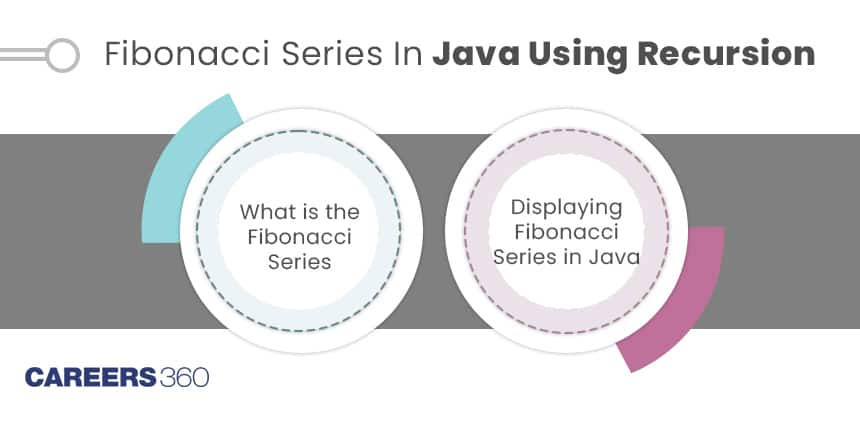Fibonacci Series In Java Using Recursion
The Fibonacci sequence is a series of numbers in which each number is the sum of the two preceding ones, usually starting with 0 and 1. This sequence has widespread applications in mathematics and computer science. This series has found its application across domains.

In this article we will explore different methods that are used to generate and display Fibonacci series in Java using Recursion. You can also pursue some of the Java certification courses listed on our website if you are interested in gaining further knowledge in this field.
Also Read:
What is the Fibonacci Series?
The Fibonacci sequence starts with 0 and 1, and each subsequent number is the sum of the two preceding ones. The Fibonacci number program in java sequence begins as follows: 0, 1, 1, 2, 3, 5, 8, 13, 21, and so on. As we progress along the sequence, the ratio of consecutive terms approaches the golden ratio, a mathematical constant denoted by the Greek letter phi (ϕ), approximately equal to 1.6180339887. Mathematically, the Fibonacci sequence is succinctly defined by the recurrence relation:
This recurrence relation encapsulates the essence of the Fibonacci sequence, illustrating how each term is the sum of its two immediate predecessors. This simple yet powerful definition serves as the foundation for understanding the inherent beauty and widespread significance of the Fibonacci sequence across various disciplines.
F(n)=F(n−1)+F(n−2)
Also Read:
Displaying Fibonacci Series in Java
The Fibonacci series is not only a fascinating numerical pattern but also a concept widely employed in mathematical theories, natural phenomena, and computer science algorithms. This section will explore the various methods, including use of ‘For’ loops, while loops, and fibonacci using recursion in Java.
Using For Loop
public class FibonacciUsingForLoop {
public static void main(String[] args) {
int n = 10; // Number of terms in the series
int firstTerm = 0, secondTerm = 1;
System.out.println("Fibonacci Series using for loop:");
// creating a loop of adding the predecessor and the successor terms
for (int i = 0; i < n; i++) {
System.out.print(firstTerm + ", ");
int nextTerm = firstTerm + secondTerm;
firstTerm = secondTerm;
secondTerm = nextTerm;
}
}
}
Using While Loop
public class FibonacciUsingWhileLoop {
public static void main(String[] args) {
int n = 10; // Number of terms in the series
int firstTerm = 0, secondTerm = 1;
int i = 0;
System.out.println("Fibonacci Series using while loop:");
while (i < n) {
System.out.print(firstTerm + ", ");
int nextTerm = firstTerm + secondTerm;
firstTerm = secondTerm;
secondTerm = nextTerm;
i++;
}
}
}
Using Recursion
public class FibonacciUsingRecursion {
public static void main(String[] args) {
int n = 10; // Number of terms in the series
System.out.println("Fibonacci Series using recursion:");
for (int i = 0; i < n; i++) {
System.out.print(fibonacci(i) + ", ");
}
}
public static int fibonacci(int n) {
if (n <= 1) {
return n;
} else {
return fibonacci(n - 1) + fibonacci(n - 2);
}
}
}
In the recursive solution, the Fibonacci series program in Java using recursion is defined to calculate the nth term of the Fibonacci series. The base case is when n≤1, in which case the method returns n. Otherwise, it recursively calls itself for n−1 and n−2 and returns the sum of the two results.
These examples showcase different ways to generate and display the Fibonacci series in Java. Depending on the context and requirements, you can choose the approach that best suits your needs.
Related: Popular providers offering Java Certification Courses
Conclusion
We have explored various methods—employing Fibonacci series in Java using for loops, while loops, and recursion—each offering its unique advantages and insights. The 'for' loop, with its structured syntax and precise control over iteration, stands out as an efficient and readable choice for generating Fibonacci sequences.
Through this exploration, Fibonacci series in Java using scanner, we have not only gained practical insights into Java programming techniques but also explored the applications of the Fibonacci sequence in Java programming to become proficient Java programmers.
Frequently Asked Questions (FAQs)
The program to print the Fibonacci series in Java typically involves using loops (such as 'for' or 'while') or recursion. The choice of method depends on the specific requirements and programming style.
Recursion involves a function calling itself, and it is another approach to generating the Fibonacci series. In Java, a recursive function calculates the nth term by summing the results of recursive calls for the two preceding terms.
The 'for' loop is a structured iteration construct in Java that facilitates precise control over the execution of a block of code. In the context of displaying the Fibonacci series, the 'for' loop efficiently handles repetitive tasks, making it a preferred choice for generating and showcasing the sequence.
Java is a versatile programming language widely used in software development. Its syntax and robust set of libraries make it suitable for implementing various algorithms, including those involving mathematical sequences like the Fibonacci series.
It is a series of numbers where each number is the sum of the two preceding ones. In programming, it is significant due to its applications in algorithmic design, and its occurrence in various natural phenomena.
